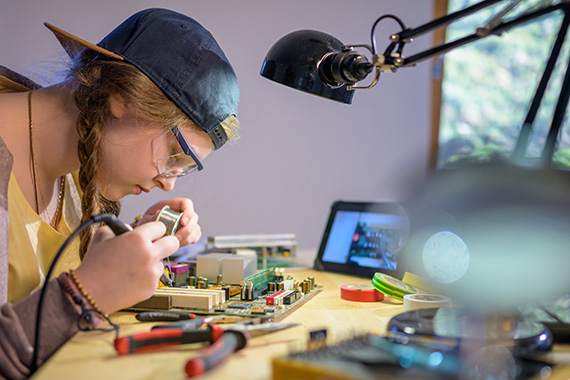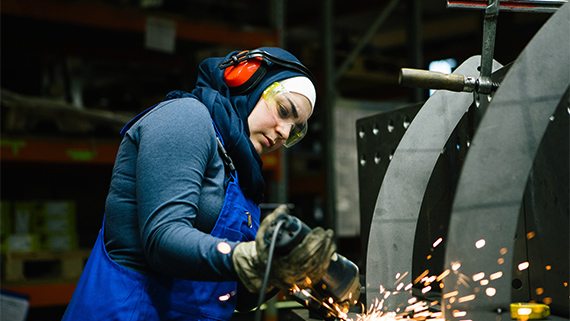Introduction
Welcome to TAS1O!
This hands-on course will enable you to further explore the engineering design process and develop other technological knowledge and skills introduced in earlier grades. You will design and safely create prototypes, products, and/or services, working with tools and technologies from various industries. As you develop projects to address real-life problems, you will apply technological concepts such as precision measurement, as well as health and safety standards. You will also begin to explore job skills programs and education and training pathways, including skilled trades, that can lead to a variety of careers.

Six people all from different skilled trades professions: a painter, a baker, a hairstylist, a doctor, a farmer, and a construction worker. All of them share a speech bubble that says ‘We all work in the skilled trades!’
In this first unit, you will explore the foundations of technology and the skilled trades. You will learn about the 10 broad-based technology subject areas and their potential pathways. You will also learn the steps of the engineering design process and use it to understand the works of designers and works of your own. The advancement of technology over time will be discussed, including how technological advancement impacts specific industries and the world at large. In subsequent units, you will explore different areas of technology and the skilled trades.
By the end of the course, you will be able to:
- understand and utilize the engineering design process
- explore careers and pathways within technology and the skilled trades industries
- apply health and safety practices and a safety mindset to various works
- practice a variety of skills related to different technology and the skilled trades subject areas
In this learning activity, you will learn about the foundations of the course, the 10 broad-based technology subject areas, and the different careers and pathways in technology and the skilled trades.
Let’s get started!
Getting started
Course icons
You will notice a variety of icons throughout the course.
Please see below for the descriptions of each icon.
Think
The Think icon indicates a moment for independent thinking and reflection.
Definition
The Definition icon appears when we are highlighting a new term. You’re encouraged to note down definitions in your notebook.
Notebook
When you see the Notebook icon, you will use your notebook to write down reflections, thoughts, or ideas.
Try it!
When you see the Try it! icon, you will be trying an activity.
Explore this!
The Explore this! icon indicates that you will explore the video included.
Assignmment
The Assignment icon appears when you will be asked to complete a graded assessment.
BBT connections
When you see the BBT connections icon, you will be learning about connections to the various broad-based technology (BBT) subject areas.
Course supplies
Technology and supplies note: As a component of TAS1O involves creating with a variety of tools and technologies, you can utilize what is accessible to you. This may be the use of available materials, equipment, applications, and/or software.
Explore this!
Check out the following video as an introduction into technology and the skilled trades.
Notebook
After viewing the video, reflect on your current knowledge and understanding of technology and the skilled trades in your notebook.
Reflect on the following prompt and write three to five thoughts that come to mind:
What do you currently think of when you hear “technology and the skilled trades”?
What is a broad-based technology?
Broad-based technology (sometimes written as "BBT") is a term that refers to the 10 different technology and the skilled trades subject areas in the Ontario curriculum.
You will learn more about each BBT subject area below!
Why is studying broad-based subject areas important?
It is important to learn about these subjects as each directly reflects a career sector in the communities we live in. These careers make positive impacts on our lives – from supporting the construction of housing, helping plants thrive and manufacturing the products we use every day!
It is important to emphasize that these subject areas are not only about being trained in a skilled trade, but also understanding health and safety, standards and regulations, environment and sustainability, essential skills, and every day work habits.

The title is ‘Broad-based Technology Subject Areas’ with 10 sections, labelled Hairstyling and aesthetics, Health care, Hospitality and tourism, Manufacturing technology, Technological design, Transportation technology, Communication technology, Computer technology, Construction technology, Green industries. Each section has a corresponding image.
Breaking down the 10 broad-based technology subject areas and work sectors
Press the following tabs to learn more about the 10 subject areas.
Notebook
Which broad-based technology subject areas sound of interest to you? Which fields may you want to explore further?
Write down your thoughts in your notebook.
What are the post-secondary pathway options?
It is important to note that each subject area can develop further into a career within several different post-secondary pathways: work, apprenticeship, college, or university.
The pathways refer to different education and/or training paths needed to gain the knowledge and skills for a field of work.

University
In the university pathway, students undergo a particular theoretical field of study and attain a degree in a subject area. A typical undergraduate degree is four years of study. Some examples of university subjects include law, engineering, and the humanities.
Discover more
Use your preferred search engine and enter the terms “Ontario Universities’ Info.”
Examine the results to further your understanding of the university pathway.
Workplace
Workplace refers to transitioning directly into the workforce after high school.
In high school, students can also earn credit while gaining work-related skills under the supervision of their school’s experiential learning program and/or co-op. This can lead to employment opportunities in a variety of fields.
Explore this!
Check out the following video entitled Post-Secondary Destination: Workplace to learn more about the workpathway.
Apprenticeship
Apprenticeship is hands-on training which is completed under the supervision of a certified “journeyperson”. Journey people are mentors who have the skills, education, and certification in a specific trade.
Apprenticeships provide access to job training, while also receiving payment to learn new skills.
Much of apprenticeship training is provided in the workplace by employers/sponsors, who provide industry-level training. The remainder may involve classroom instruction, which is usually given at a local community college or provided by another approved training organization.
Ontario Youth Apprenticeship Program (OYAP)
The Ontario Youth Apprenticeship Program (OYAP) is an opportunity for Ontario students to attain secondary school credits while also gaining job experience in the skilled trades.
Explore this!
Check out the following video entitled What Is OYAP? to learn more about the apprenticeship pathway.
Discover more
Use your preferred search engine and enter the terms "Ontario Youth Apprenticeship Program.”
Examine the results to further your understanding of the apprenticeship pathway.
College
In the college pathway, students earn a diploma in an area of specialty. This is often attained through courses, theory, and practical application. Some examples of college-based courses in the skilled trades could include automotive technology, computer technology, green technology, and construction technology.
Discover more
Use your preferred search engine and enter the terms “Ontario Colleges.”
Examine the results to further your understanding of the college pathway.
Explore the following video which provides insight into post-secondary options in the trades and breaks down the stigma around college versus university pathways.
Explore this!
Check out the following video entitled How To Tell Your Parents You’re Not Going To University to learn more.
Notebook
After viewing the video, consider where you might want your career journey to lead. What type of job or training would interest you?
Reflect in your notebook.
It is important to remember that everyone has their own path to discovering which career and training works best for them.
Notebook
Select one broad-based technology area and brainstorm careers in that field that may interest you. Next, select one of those careers to research further in your notebook.
Based on your research, note the job title, an overview of what skills may be needed or recommended for a career in that field, as well as insights into the post-secondary pathways of that career.
You may wish to explore a variety of resources on the internet, such as the OYAP or Ontario Colleges website, and/or research job postings to see what is listed by potential employers.
Conclusion
In this learning activity, you explored an overview of the 10 broad-based technology subjects, educational pathways and examples of careers in the technology and the skilled trades industries.
Notebook
Reflect on your learning from this first activity.
In your notebook, write two or three takeaways that will help you as you move forward in the course.
In the next learning activity, you will begin learning about health and safety practices within technology and the skilled trades.
Connecting to transferable skills
Ontario worked with other provinces in Canada to outline a set of competencies that are important to have to be successful in today’s world. Ontario then developed its Transferable Skills Framework as a set of skills for students to develop over time.
Explore the following video to learn about each of the seven transferable skills.
To learn more about each of the transferable skills, read the following document entitled Transferable Skills Overview (Opens in a new tab) to explore the framework and the descriptors for each skill. Download, print, or copy the information in the document into your notes - you'll refer to it in each unit.
Throughout this course, you will be given the opportunity to reflect on the transferable skills you are developing. Keep your notebook up-to-date and be mindful of opportunities to apply and develop transferable skills.
Self-check quiz
Check your understanding!
Complete the following self-check quiz to determine where you are in your learning and what areas you need to focus on.
This quiz is for feedback only, not part of your grade. You have unlimited attempts on this quiz. Take your time, do your best work, and reflect on any feedback provided.
Press Quiz to access this tool.












